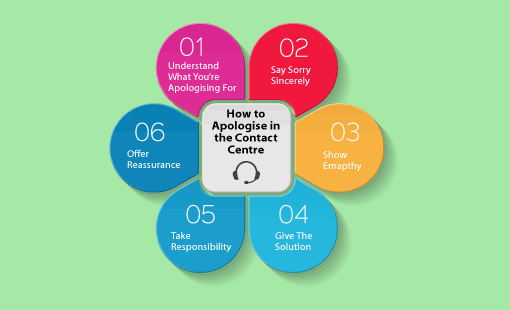Miss that chance to apologise well and the company will lose business; embrace it and the business will have a customer for life.
Try following these six steps to crafting that all-important contact centre apology, with extra tips for saying sorry over the phone or via live chat and email.

1. Understand What You’re Apologising for
An apology through gritted teeth is worse than none at all.
It is impossible for an advisor to give a genuine apology until they have fully understood what’s happened. So it’s important to acknowledge the customer first, thank them for their contact and listen carefully.
Don’t dive in with a throwaway apology just because “the customer is always right”. An apology through gritted teeth is worse than none at all.
Additional Advice for Live Chat and Email
An upset customer often starts their email with the straw that broke the camel’s back. But that might not be the main issue, so the advisor will need to read between the lines to figure it out.
Handling a customer interaction on live chat means asking the right questions: “When did this problem start?” And let the customer know that they are being listened to by using quick phrases, such as: “I can see that”, “I understand” and “Yes, of course.”
Additional Advice for the Phone
Active listening is the key here. This is a technique where an advisor conveys to the customer that they are concentrating fully, making reference to what the customer is saying, to emphasise to them that they have the advisor’s full attention.
A key part of this is to use “verbal nods” when the customer is talking. These reassure the customer that there is someone on the other end of the phone, doing their best to understand the issue.
Examples of these verbal nods simply include saying “yeah” or “uh-huh” when the customer comes to the end of their sentence.
For more on this topic, read our article: Ten Tips to Improve Listening Skills on the Telephone
2. Say Sorry Sincerely
Saying sorry is the most effective way to make up for a poor customer experience. Hopefully, the team are fully aware of how to get that right before advisors launch in with a quick fix.
Once the advisor knows exactly what they are sorry for, it is important to be sincere about it, to say something like: “I’m sorry our call handler was rude and unhelpful.”
Don’t take a ‘one size fits all’ approach with: “Please accept my sincere apologies for your recent experience.” Make the apology personal, as otherwise it will lack authenticity.
Advisors should avoid a “non-apology” at all costs. Don’t put the problem back on the customer and tell them “I’m sorry you feel that way.”
Also, advisors should avoid a “non-apology” at all costs. Don’t put the problem back on the customer and tell them “I’m sorry you feel that way.”
Don’t doubt the customer’s experience by saying something along the lines of “I’m sorry if our call handler was rude.” And never put things down to bad luck with “Unfortunately…”. This goes for any channel, whether it’s live chat, email or the phone.
3. Show Empathy and Reflect Back
The customer has suffered poor service and they have gone to the trouble of making a complaint. They are feeling disappointed, frustrated and/or upset, so it’s important to validate those feelings.
It may seem clichéd, but it’s important for the advisor to put themselves in the customer’s shoes, to say something like: “I appreciate you bringing this distressing situation to my attention. Let me see what I can do to help.”
In addition, it can be helpful to reflect back any specific details that they have mentioned to show an understanding. For example: “…especially as we’d assured you it would arrive in time for Christmas.”
Advisors should also be warned against undermining that empathy by countering it with an excuse, by saying something such as “While I appreciate this delay is frustrating, we’re currently processing a high volume of orders.”
For a list of phrases that are useful for advisors when showing empathy, read our article: 18 Empathy Statements That Help Improve Customer-Agent Rapport
4. Give the Solution
Now the customer is ready to hear the advisor’s solution. However, simply dishing out a refund will only win over 37% of disgruntled customers, as highlighted in a Nottingham School of Economics study.
Remind advisors to put emphasis on the solution, rather than reverting to the problem, to try and keep the interaction upbeat.
But after the advisor has said sorry and shown that they care, the chances of earning the customer’s forgiveness have already increased massively.
Make the solution hassle-free and do the legwork for the customer, telling them that: “I’ve sent out a replacement to you, free of charge.”
Don’t put them to more trouble and say something like: “Please reorder your item and call our billing team to refund the charge.” Remind advisors to put emphasis on the solution, rather than reverting to the problem, to try and keep the interaction upbeat.
To go one better, the contact centre could allow advisors to make a heartfelt goodwill gesture. For example, allow the advisor to say: “I’m also taking £25 off your next bill to show we’re sorry for the stress we’ve caused.”
Offering “£25 off your next bill in line with our customer promise” isn’t so meaningful, yet it’ll cost the company the same.
5. Take Responsibility
Whether the mistake was intentional or not, the outcome is the same for the customer. They deserve an explanation of exactly what’s gone wrong, and why. This is a chance to rebuild trust, so advisors must be encouraged to be transparent.
This encouragement involves asking advisors to hold their hands up and take ownership of the error, even if it wasn’t made by them. An advisor can do this by saying something along the lines of: “I should have made this clearer to you when you placed your order.”
Using active language is helpful when taking responsibility, saying something such as: “I made a mistake when I debited your account.” And it’s important to be specific, to say: “I debited £143.00 instead of £14.30”.
Another tip would be to avoid jargon, as illustrated in the following phrase: “It would appear… an error was made… we placed a negative marker on your file.”
The passive construction and alien jargon included in the statement above create barriers to understanding, which can often make an advisor sound underhand.
6. Offer Reassurance – but Don’t Make Promises That You Can’t Keep
By this point, the advisor is well on their way to turning your customer’s negative experience into a positive one. But before the call ends, it is important to restore your customer’s faith in the business. Give them a reason to come back.
Advisors should avoid making boastful claims such as: “We’re proud to offer our customers a first-class service.” That completely contradicts the customer’s experience.
Reflect company values by using phrases like: “We’re committed to offering exceptional service to all our customers.”
Also, it may be useful to explain any improvements that the company is making to its service, by saying something like: “We don’t want this to happen again, so we’ve upgraded our delivery service.”
But advisors should avoid make boastful claims such as: “We’re proud to offer our customers a first-class service.” That completely contradicts the customer’s experience.
In addition, advisors should be warned against making promises that the company can’t keep. This could include common contact centre phrases like: “We’ve taken steps to ensure this will never happen again.”
Wrapping up by thanking the customer again, and signing off with their name, is great practice for a contact centre advisor. Doing this shows accountability and a personal commitment to putting things right.
And if things have really gone right, the customer will drop a line or make a statement to personally thank the advisor for their help.
For a full run-down of how to close a call, read our article: The Best Call-Closing Statements
Thanks to Tamara Carlier, Trainer & Coach at The First Word, for helping to put this article together.
For more advice on offering apologies in customer service, read our articles:
- 16 Customer Service Apology Statements
- “Sorry for the Inconvenience” – How to Offer a Genuine Apology
- How to Write a Customer Apology Letter – With an Example
Author: Robyn Coppell
Reviewed by: Megan Jones
Published On: 21st Feb 2018 - Last modified: 1st Feb 2024
Read more about - Customer Service Strategy, Apologies, Customer Service, Editor's Picks, Email, Empathy, Language, Live Chat








































